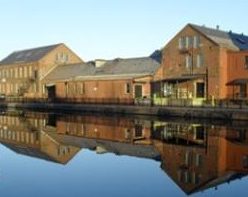[Drive along Canal Street until you are in front of the Albion.]
These six paper mills are along the northeast sector of the Second Level Canal. Their order from the Vietnam Veteran Bridge as they swept to the east and then south are the Valley Paper Mill, Crocker Paper Mill, Albion Paper Mill, Mt Tom Paper Mill, Nonotuck Paper Mill, and Gill Paper Mill. All had one or two races below them that emptied into the river beyond. All have their unique history and specialties. The Albion was constructed by Joseph Newton from products that were made in Holyoke except for the South Carolina Yellow Spruce that is in its rafters. The external architecture of the Albion was Victorian with a subtype of Second Empire. Note the rooftop with its elegant mansard. The Crocker specialized in colored paper. The Mount Tom Mill was known as the Syms Paper Mill until the Nonotuck took it over. The Gill was known as the Winona for its first ten years until it had a new owner. The Gill was a leader in worker’s rights within Holyoke especially during the consolidation era of the 1890s.
Many of these mills are gone but the Valley and the administration wing of the Nonotuck are still with us. The large smokestack is from the Gill Mill.
There are 18 active hydroelectric turbines in the races that still exist in Holyoke. There once existed about 200 millraces in the city. These small or medium sized turbines generate 20 Megawatts of electricity. Including the turbines at the dam, Holyoke now generates 55 MW total. This is three quarters of what Holyoke uses. At its peak in history the canal and dam system generated 100 MW total power. Thus there is 45 MW lacking from the system. Building another hydroelectric station along this bend of the canal would get some of that power back.
Sanborn map analysis:
